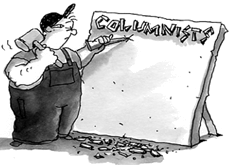Between a Rock Chopper and a Hard Place
 Friday, November 15, 2024
Friday, November 15, 2024 Church abuse survivor given the Bird ... High Court and the "agency" of Catholic priests ... No liability for predatory clerics ... How did we get to this? ... What would Peter McClellan think? ... Procrustes on the latest loophole for the church
 Bishop Bird: no vicarious liability
Bishop Bird: no vicarious liability
Your scribe's media lit up like an Iraqi oil well in the presence of an Abrams tank, messages flooding in by native bearers with forked sticks, even the camel express arrived, bearing the news: the High Court has found the Catholic Church (in the shape of Bishop Paul Bird, in charge of the Ballarat Diocese) not liable for the predatory kiddy fiddling of one of the Diocese' priests, Bryan Coffey (1934-2013): see Bishop Bird v DP (a pseudonym) [2024] HCA 41, November 13, 2024.
In the wake of the Royal Commission into Institutional Responses to Child Sex Abuse (2013-2017), a heavy lifting operation headed by Peter McClellan from the NSW Supremes, the end product for DP, the pseudonymised victim, looks pretty paltry.
Coffey was convicted in 1999 on 12 counts of indecent dealing with minors and sentenced to three years chokey, which the beak then suspended on the basis of no priors.
Further allegations followed, but as is the way in these matters, the prosecutions folded on the non-appearance of the victims. Coffey went to his grave a free man.
Now look at the plurality judgment in Bird (Gageler CJ, Gordon, Edelman, Steward, and Beech-Jones JJ) at [12]-[13] for a summary of the uncontested facts as found by the trial judge.
The diocese commissioned Coffey as a priest, ensured his accommodation, his priestly garb and living wage, and above all controlled his movement around western Victoria from the '60s to the '90s.
The first sign of weakness in the plurality reasoning is that their Highnesses are happy to recite the indicia of control, but don't make the connection to the critical power of the diocese in using that control over Coffey's location to shuffle him along as outraged parents in parish after parish complained about his activities.
This sets the scene for the High unanimously, in three judgments, pronouncing the Bishop, as the nominated defendant under Victorian law, not vicariously liable for the tortious damages arising from Coffey's malign activities.
The relationship of priest to the church is said to be insufficiently like that of an employment relationship - the standard template for allocating liability vicariously.
From the vantage point of DP, now in his 50s but aged five when Coffey turned up at the family home in Pt Fairy and monstered him, Australian common law is hardly covering itself with glory.
Coffey never imprisoned, and the church which put Coffey in the space where he could abuse the trust engendered by Catholic doctrine, not liable at law for the damage done to a small child. How did we get to this?
Every sophisticated society needs to provide for actions to be performed by agency: we get others to undertake activities on our behalf.
It's a fundamental premiss of government - corporate life rests on it. But governments and companies rely on clear cut employment relationships to determine their degree of control and consequent liability for the actions of their agents.
Yet the Catholic, and other churches, are examples of large operations where the law has bogged itself in a quagmire over determining liability for tortious damage created by agents.
 Coffey: shuffled from parish to parish
Coffey: shuffled from parish to parish
Faced with serious financial repercussions if abuse damages are to be sheeted home to Mother Church, the hierarchy (the late lamented Cardinal Pell at the helm) and attendant lawyers worked prodigiously to fend off liability for predatory priests.
The NSW Court of Appeal delivered in spades in 2007 with the Ellis defence, accepting that the Catholic Church did not have sufficient tangible form to be sued.
Royal Commission recommendations led to the overturning of that doctrine (hence Bishop Bird being the nominated defendant under Victorian legislation), but now a new road block: the incorporeal form of the Church is just too vague to permit liability to fall on it when its robed representatives, displaying a very distinctive corporate get up, go seriously off reservation.
This can only be described as curious, given the terminology used in the plurality reasons (at [14]-[15]).
Coffey's role was integrally interconnected with the fundamental work and function of the diocese. The primary judge found that there was a "general or widely held expectation by the Port Fairy Catholic community" that "priests stood as representatives of the church's values and must embody them always" and that "Coffey carried out the work of the diocese 'in its place'." Coffey was described as "the servant of the diocese" and as an "emanation" and "representative" of it. By virtue of his role as assistant parish priest, Coffey's work "comprised the 'very essence' of the public manifestation of the diocese and the church in Port Fairy" and he commanded the respect and trust of the local parishioners.
As assistant parish priest, Coffey did the work of the diocese in the parish and the diocese did its work by and through him. The primary judge found that the "diocese, through the bishop, [had given] Coffey the imprimatur to undertake religious caring for the spiritual life of the Port Fairy flock". This included ... visits to parishioners' homes (emphasis added).
That all emerged from the unchallenged finding of Jack Forrest J at first instance, who had been upheld by the Vic CA. How is it that in the face of findings as to "work ... representative ... emanation ... respect and trust [and] imprimatur" the court just couldn't see its way to enough agency to sustain liability.
The answer seems to lie in a culture of limitation in this aspect of the law, rather than a progressive analysis, such as was seen in the indefinite detention case, NZYQ [2023] HCA 37, and its sequel, the ankle bracelet case, YBFZ [2024] HCA 40.
The latter gave us a clarion call to the common law's control of state power:
"The lineage of the common law's refusal to deny its fundamental protections against arbitrary punishment by deprivation of life, bodily integrity, and liberty to aliens within its jurisdiction is long and distinguished."
Bird on the other hand ducks for cover, justifying departure from British and Canadian acceptance in recent years that agency principles are sufficiently broad to allow for liability to fall vicariously on church organisations.
Australian common law has always been weak on the subject of liability falling on authority. The ridiculous Enever doctrine (the Crown not liable for the independent functions of constables) dogged police for most of the twentieth century until each jurisdiction legislated for its removal (noting the judicial tendency to clutch at antiquated soft legal toys, as when Moore J resurrected Enever to insulate the National Crime Authority from tort liability in Malubel Pty Ltd v Wendy Elder [1997] FCA 1310).
You might have hoped that Coffey being declared an "emanation" of the diocese would ring the bell for their Highnesses: one of the tests for determining whether a body is an emanation of the Crown is whether a minister has ultimate control.
The case law reveals a far greater degree of independent discretion must be involved than Coffey had before Crown control (by analogy with the church, tort liability) is relinquished.
There is not space here to do justice to Jacqueline Gleeson J's encyclopaedic analysis of the matter, in which her Hon at length rebuts the timidity of her colleagues, and justifies moving the common law in Oz onto equal footing with that in the UK and Canada (and she notes Ireland).
She was able to wave to her Dad's judgment in Lepore in 2003 as being in line with that possibility. However, her conclusion in the last page of this important dissent by dicta is curiously tame: the Church is not liable because the assaults committed by Coffey, although occurring in the light of trust in the clergy, did not arise from any specific part of his clerical role. He was not required to be alone with the victim.
This is a factual restriction as witless as the reductionist legal analysis of the plurality.
All three judgments display a recognition of the Royal Commission's impact, and the resulting legislative changes, but that of Jayne Jagot J's perhaps most insistently.
I can only wonder what her husband, Peter McClelland, thinks of this result. The breathless anticipation (see Leeming "Theories and Principles Underlying the Development of the Common Law: The Statutory Elephant in the Room" 2013 UNSWLJ) that the common law and statutes could evolve hand in hand has been dashed, yet again.









Reader Comments